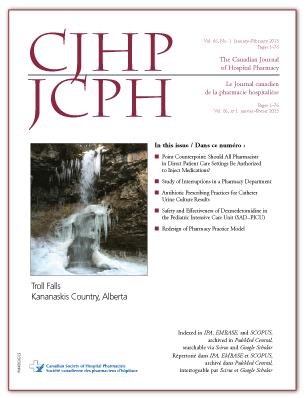Antibiotic Prescribing Practices for Catheter Urine Culture Results
DOI:
https://doi.org/10.4212/cjhp.v66i1.1207Keywords:
antibiotic, antimicrobial, asymptomatic bacteriuria, catheter, prescribing, La pertinence de la prescription d’antibiotiques, telle qu’elle a été mesurée en fonction de la concordance des décisions entreAbstract
ABSTRACT
Background: The literature suggests that positive results of catheter urine cultures frequently lead to unnecessary antimicrobial prescribing, which therefore represents an important target for stewardship.
Objective: To assess the appropriateness of antibiotic prescribing in response to the results of urine cultures from patients with indwelling urinary catheters.
Methods: This retrospective study was conducted at a tertiary care centre and involved adults with indwelling urinary catheters from whom urine specimens were obtained for culture. Patients with positive or negative culture results were identified from microbiology laboratory reports. The medical records of consecutive patients were screened to select a sample of 80 inpatients (40 per group). Abstracted patient histories were independently evaluated by an expert panel of 3 infectious diseases consultants blinded to the decisions of prescribers and of fellow panelists. The primary end point was concordance of each patient’s treatment decision (with respect to the indication) between the expert panel (based on majority agreement, i.e., at least 2 of the 3 expert panelists) and the prescriber. The secondary end points were unnecessary days of therapy and selected outcomes over a predefined period after urine was obtained for culture.
Results: A total of 591 charts were screened to generate the targeted number of patients. Baseline demographic characteristics were comparable for the 2 groups, except antibiotic exposure before urine collection was significantly more frequent for the group with negative culture results. The treatment decision was concordant in 40% (16/40) of the patients with a positive culture result and 85% (34/40) of those with a negative culture result (p < 0.001). The most common reason for discordance was administration of antibiotics when not indicated (23 of 24 patients with a positive result and 5 of 6 patients with a negative result), which accounted for 165 and 32 unnecessary days of therapy per 1000 inpatient-days, respectively (p < 0.001). Adverse effects occurred in 2 of the 23 patients with a positive result who received antibiotics that were not indicated.
Conclusions: Appropriateness of antibiotic prescribing, as measured by concordance of decisions between the expert panel and prescribers, was more common among patients with negative urine culture results than among those with positive results. However, there is an opportunity to improve prescribing for both groups through antimicrobial stewardship initiatives. Unnecessary days of therapy and adverse effects were more common in patients with a positive culture result.
RÉSUMÉ
Contexte : Selon la littérature, des résultats positifs à des cultures d’échantillons d’urine prélevés à partir d’une sonde vésicale entraînent souvent la prescription inutile d’antibiotiques; par conséquent, cette situation représente un objet important de gestion responsable des antimicrobiens.
Objectif : Évaluer la pertinence de la prescription d’antibiotiques sur la base de résultats des cultures d’échantillons d’urine prélevés chez les patients porteurs d’une sonde vésicale à demeure.
Méthodes : La présente étude rétrospective a été menée dans un établissement de soins tertiaires auprès de patients adultes porteurs d’une sonde vésicale à demeure chez qui on a prélevé des échantillons d’urine à des fins de culture. Les patients avec des résultats de culture positifs ou négatifs ont été repérés à partir des rapports de microbiologie. Les dossiers médicaux d’une série consécutive de patients ont été examinés afin de choisir un échantillon de 80 patients hospitalisés (40 par groupe). Les historiques abrégés des patients ont été évalués indépendamment par un panel d’experts composé de trois consultants en maladies infectieuses qui ignoraient la décision des prescripteurs et les résultats des évaluations de leurs collègues panélistes. Le paramètre d’évaluation principal était la concordance de la décision thérapeutique (quant à l’indication) pour chaque patient entre le panel d’experts (selon un accord majoritaire, c.-à-d. au moins deux des trois panélistes experts) et le prescripteur. Les paramètres d’évaluation secondaires étaient le nombre de jours de traitement inutiles et certains résultats cliniques sur une période prédéterminée après l’obtention d’un échantillon d’urine à des fins de culture.
Résultats : Un total de 591 dossiers de patients ont été analysés afin d’obtenir le nombre cible de patients pour l’étude. Les caractéristiques démographiques initiales étaient comparables dans les deux groupes, sauf l’exposition aux antibiotiques avant le prélèvement d’urine qui était significativement plus fréquente dans le groupe de patients ayant obtenu des résultats de culture négatifs. La décision thérapeutique concordait pour 40 % (16/40) des patients ayant obtenu des résultats positifs à la culture d’urine et pour 85 % (34/40) de ceux qui avaient obtenu des résultats négatifs (p < 0,001). La raison la plus fréquente expliquant la discordance entre les décisions thérapeutiques était l’administration non indiquée d’antibiotiques, une circonstance observée chez 23 patients sur 24 ayant obtenu des résultats positifs et 5 patients sur 6 ayant obtenu des résultats négatifs. Ces cas ont contribué respectivement à un total de 165 et de 32 jours de traitement inutiles par 1000 journées-patients hospitalisés (p < 0,001). Des effets indésirables sont survenus chez deux des 23 patients ayant obtenu un résultat positif et reçu des antibiotiques non indiqués.
Downloads
Published
Issue
Section
License
Copyright © Canadian Society of Healthcare-Systems Pharmacy.
After publication of a manuscript in the CJHP, the authors of the manuscript must obtain written permission from the CSHP (publications@cshp.ca) before reproducing any text, figures, tables, or illustrations from the work in future works of their own. If a submitted manuscript is declined for publication in the CJHP, all said rights shall revert to the authors. Please note that any forms (e.g., preprinted orders and patient intake forms) used by a specific hospital or other health care facility and included as illustrative material with a manuscript are exempt from this copyright transfer. The CJHP will require a letter from the hospital or health care facility granting permission to publish the document(s).










